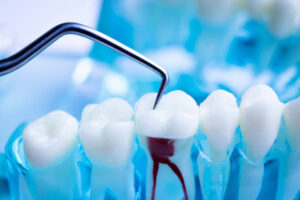
Root canal therapy is a successful procedure to save an infected tooth from needing to be extracted. The treatment has over a 97% success rate; however, some patients may require retreatment. Not everyone will require a second root canal, but several factors can increase your risk of complications. Here’s when root canal retreatment may be necessary and what you can expect during the procedure.
Common Causes of Root Canal Retreatment
Complications following root canal therapy can occur shortly after the procedure or many years down the road. Common causes of root canal retreatment include:
- Delayed Crown Placement: Often, a dental crown is needed to protect a tooth after it has been treated with a root canal. Delaying crown placement can cause bacteria or new decay to be trapped underneath the restoration.
- Complex Root Chambers: Some teeth have multiple or curved root chambers, which can be difficult to clean out completely.
- New Decay: Decay can occur underneath the restoration from poor oral hygiene.
- Vertical Fracture: Undetected vertical fractures of the tooth root can lead to complications.
- Microleakage: Small cracks form in the dental cement that’s holding your crown in place over time. This can allow bacteria to gain access to your tooth.
Symptoms of Reinfected Root Canal
Some patients experience no signs of root canal failure; however, common symptoms may include:
- Pain: You may experience a persistent toothache or sharp pain when placing pressure on the tooth.
- Swelling: Your gums surrounding the tooth may become inflamed or an abscess may form.
- Pus or Drainage: Drainage or leakage near the tooth are signs of an infection.
- Discoloration: Discoloration of the gum tissue or teeth surrounding the tooth can occur.
- Foul Taste or Bad Breath: You may have a bad taste in your mouth or suffer from chronic bad breath.
What to Expect with Root Canal Retreatment
Retreating the tooth is similar to your initial root canal. Your dentist may use a numbing medication to block any pain as they remove your crown and the packing material within your tooth. Your tooth will be cleaned out and sterilized before being packed with gutta-percha. They will take an impression of your mouth to create a new restoration to place over your tooth. Your tooth will have the protection it needs to last for a lifetime with the correct care.
About Dr. Andrew Ricci
Dr. Ricci achieved his dental degree at the University of Southern California Ostrow School of Dentistry and has completed advanced training in root canals, oral surgery, complex restorative procedures, and dental implants. He is a proud member of many professional organizations, including the American Dental Association and the Academy of General Dentistry. Request an appointment through his website or call his office at (303) 974-4442.
